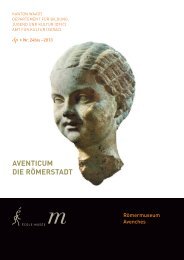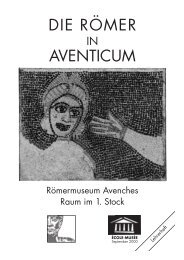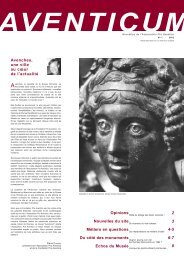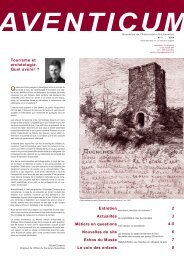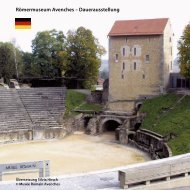Avenches – Roman Museum – Permanent Exhibition
Avenches – Roman Museum – Permanent Exhibition
Avenches – Roman Museum – Permanent Exhibition
You also want an ePaper? Increase the reach of your titles
YUMPU automatically turns print PDFs into web optimized ePapers that Google loves.
Ground Floor The Gallo-<strong>Roman</strong> Population of Switzerland and Their View of Death<br />
Funerary Urns<br />
5. Tombstone of Decimus Iulius Iunianus (1)<br />
Erected by his wife.<br />
Limestone. West gate necropolis.<br />
1st <strong>–</strong> 3rd centuries AD. Catalogue of inscriptions no. 11.<br />
6. Tombstone of Flavia Severilla<br />
Erected by her husband. She passed away at the age of 36 (?).<br />
Limestone. West gate necropolis.<br />
Probably 3rd AD. Catalogue of inscriptions no. 12.<br />
7. Tombstone fragment<br />
Bust of a couple with only the head of the man preserved. The names of the deceased<br />
were inscribed on the base, which, however, was lost.<br />
According to the hairstyle and stylistic features of the head, the tombstone dates from<br />
the beginning of the 2nd century AD.<br />
Limestone. West gate necropolis.<br />
8. Funerary monument of a family<br />
Limestone block with sculptures. Originally the funerary monument of a family consisted<br />
of three blocks placed on top of each other in a pilaster-framed niche. Only the badly<br />
preserved top block still remains. The sculpture depicted a couple facing each other. This<br />
type of representation is not rare and, a child was often placed between the man and the<br />
woman. In this instance, only the top of the child’s head is still visible. The mother has put<br />
her right hand on her son’s head while the father, in a similar gesture, is holding a scroll in<br />
his left hand. The pose of the couple is reminiscent of the gesture of uniting right hands<br />
(dextrarum iunctio) symbolising marriage. In a funerary context, this gesture symbolises<br />
the couple being united in life and death.<br />
Second half of the 2nd century AD.<br />
Funerary Urns (2)<br />
(Display case and drawer 1)<br />
1. Urn with ceramic cover<br />
Ceramic cooking pot covered with a mortarium and turned into an urn.<br />
En Chaplix necropolis. AD 100/150 <strong>–</strong> 200.<br />
2. Cover of a marble urn (?)<br />
This probably came from a child burial. In fact, figurines of the child-like God Eros on<br />
tombs for children symbolised their becoming god-like. Sleeping Amor or Somnus (the<br />
god of sleep) on a lion skin are images of Hellenistic origin. Sleep, usually interrupted by<br />
waking up, was set in close context with death and resurrection.<br />
Late 1st century AD.<br />
3. Lead urn<br />
Hammered lead vessels are rather rare finds; most of them were made of several pieces.<br />
West gate necropolis.<br />
4. Glass urn<br />
This bellied pot originally served as a storage vessel.<br />
En Chaplix necropolis. AD 150 <strong>–</strong> 200/250.<br />
5. Glass urn with lid<br />
En Chaplix necropolis. AD 70 <strong>–</strong> 100/120?<br />
1<br />
2<br />
9<br />
Ground Floor<br />
1



